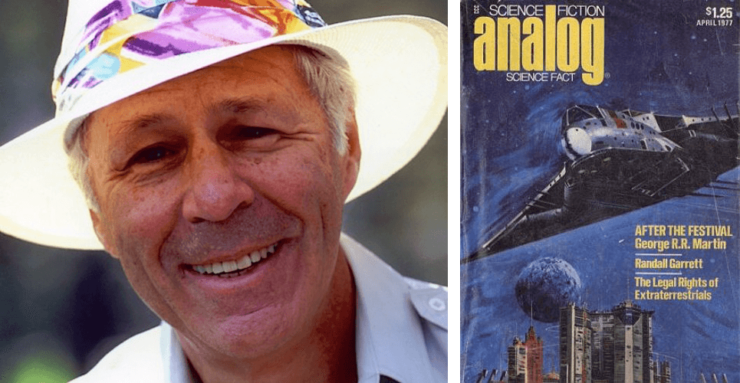Amongst the items on the late Ben Bova’s impressive CV is his turn as editor of Analog Magazine. It was a challenging job, in that he was taking over as editor following a colourful figure who had held the position for decades. I did not fully appreciate this fact at the time, since the first issue of Analog I purchased was the one pictured above, well after Bova’s inaugural issue.
By the time the April 1977 issue came out, Bova had been Analog’s editor for six years. For me, the Bova version of Analog was the Analog by which I judged all other Analogs. When I had a magazine collection, prior to the Insufficiently-Secured-Roof-Tarp Flood Event, my Analogs were most of them Bova editions.
One measure by which one can judge editors is their skill at finding new authors. Sure, one can just keep publishing the folks the previous editor published without seeking out new voices…but that’s an easy path to creative stagnation. In any case, Bova did seek out many new authors. Here are five examples of authors who got their start in his magazine.
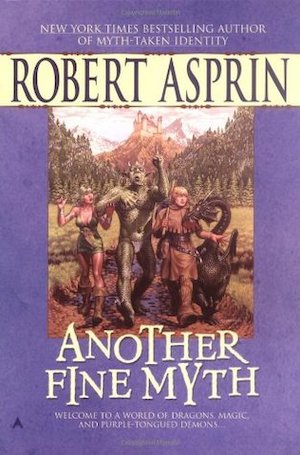
Robert Asprin’s debut short story, “Cold Cash War,” made the cover of Analog Science Fiction/Science Fact, August 1977. Later expanded to novel length, it depicts a dystopian world in which mercenaries clash on high-tech battlefields that are intended to be non-lethal (which is not always the case). Modern readers might see in this story the seeds of the next decade’s cyberpunk genre. Me, I think the novel has more in common with Mack Reynold’s Joe Mauser series.
While “Cold Cash War” started Asprin’s career, his most popular series was probably his Myth Adventures comedies. Asprin wrote fifty or so books, of which over twenty were in the Myth series. The first of these was 1978’s Another Fine Myth, in which a combination of a poorly timed prank and an all too successful assassination attempt forces teamwork between a knowledgeable but powerless Pervect and a naïve novice wizard whose magical potential is more than matched by his ignorance and gullibility. If you’ve wondered what a Hope and Crosby Road to… movie would look like as a fantasy, here’s your answer.
(If you don’t know what a Road to… movie is, follow this link or ask your grandparents…)
Another Fine Myth is still in print, as is the Phil Foglio graphic novel adaptation.
***
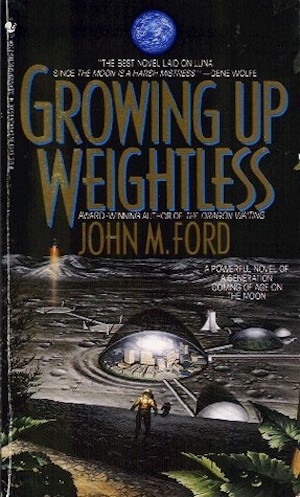
John M. Ford’s first professionally published story was “This, Too, We Reconcile,” published in Analog Science Fiction/Science Fact, May 1976. In it, a telepath is hired to read the mind of a martyr to determine if the dead man saw anything of the afterlife as he died and if so, what that afterlife is like. Rather alarmingly, the telepath is the second person hired for the job, his predecessor having committed suicide immediately after reading the martyr’s mind. This has all the earmarks of a task from which one should flee posthaste, but unluckily for our protagonist, his diligence outweighs his prudence.
This is admittedly a minor Ford, which may explain why it was never collected in either of the two Ford collections, From the End of the Twentieth Century (1997), and Heat of Fusion and Other Stories (2004). Nor has it been included in any anthology of which I am aware. Still, Bova saw enough in the story to help launch a career that lasted until Ford’s untimely death in 2006.
As you no doubt are aware, Ford’s work is being republished after a lengthy hiatus. It’s hard to think of which of his works new readers might want to sample first (many good books, but good in different ways), but perhaps the safest selection would be Ford’s 1993 Heinlein-like Growing Up Weightless.
***
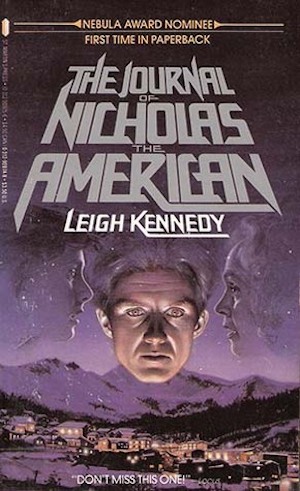
Leigh Kennedy’s first professionally published story was “Salamander.” It appeared in Analog Science Fiction/Science Fact, June 1977, an issue significant because it was the special Women’s Issue, with fully half of the contents by women. It was a pretty awesome issue and the only reason I’ve not tried to get Tor.com to pay me to review a forty-three-year-old issue of Analog is because I already reviewed it on my site.
In an apparent hat tip to the guest editorial, Kennedy’s tale depicts the alarming discovery by the stalwarts of tomorrow’s Moon community that one cannot simply handwave away human tendencies to in-groupness and dissension in new environments. At least, not if one plans to use humans. It’s a decent enough story, which was unfortunately not included in her 1986 collection Faces. I cannot say if it is in her collection Wind Angels. In any case, that appears to be out of print. Imagine my extreme frustration.
Readers new to Kennedy should seek out her 1986 Nebula-nominated The Journal of Nicholas the American, in which an empath encounters someone who needs his gifts. Using those gifts will come at a cost.
***
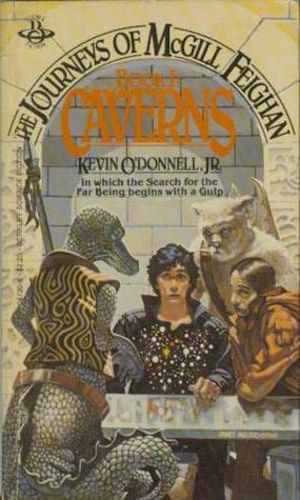
Kevin O’Donnell, Jr’s debut short story, “The Hand is Quicker,” first published in Analog Science Fiction/Science Fact, October 1973, offered Analog readers a familiar enough tale of psionic derring-do, in which a man struggles to work out how to use a minor talent for telekinesis to carry out a lucrative burglary. As he finds out, there were far more pressing questions he should have asked instead.
As far as I know, no collections of O’Donnell short works were ever published, so if you want to read this story, you will need to look for a used Analog back issue. More annoyingly, although we live in a golden age of eBook reprints, O’Donnell does not appear to have been a beneficiary of the age. All of his books seem to be out of print. If you’re willing to make the effort to hunt down used copies, I would recommend his The Journeys of McGill Feighan sequence—Caverns (1981), Reefs (1981), Lava (1982), Cliffs (1986)—a quartet in which a young man with a knack for very long-range teleportation is caught up in galactic shenanigans.
***
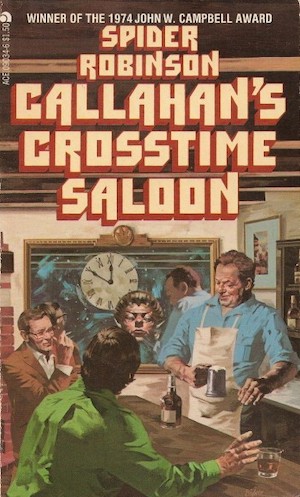
Spider Robinson’s “The Guy with the Eyes,” which appeared in Analog Science Fiction/Science Fact, February 1973, began not just Robinson’s career but what is arguably his most successful series. Callahan’s saloon provides its damaged patrons a safe haven from life’s traumas…but can it do anything for the alien scout who realizes all too late that the bar is evidence that humans are not as awful as he assured his masters they were? Failure to find some way to sidestep the robot’s easily circumvented programming means Earth in general and Callahan’s in particular are doomed. Dooooooomed.
Surprising few lengthy series begin by making further stories in the sequence impossible. Informed readers may be able to guess how this all plays out. Nevertheless, fans responded very positively to the essential conceit behind the series, resulting in not just the ten volumes in the series, but also online communities dedicated to recreating in the virtual world the allure that they found in Robinson’s work. Consequently “The Guy with the Eyes” is available in the first Callahan’s collection, Callahan’s Crosstime Saloon, still in print forty-three years after first publication.
***
No doubt those of you of my antique vintage can think of other authors who were given their start by Bova. Please feel free to name them in comments.
In the words of Wikipedia editor TexasAndroid, prolific book reviewer and perennial Darwin Award nominee James Davis Nicoll is of “questionable notability.” His work has appeared in Publishers Weekly and Romantic Times as well as on his own websites, James Nicoll Reviews and Young People Read Old SFF(where he is assisted by editor Karen Lofstrom and web person Adrienne L. Travis). He is a four-time finalist for the Best Fan Writer Hugo Award and is surprisingly flammable.










